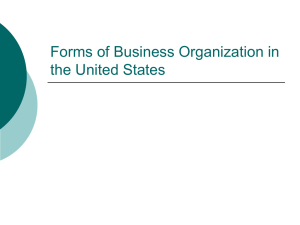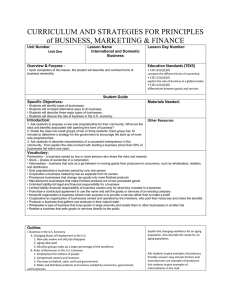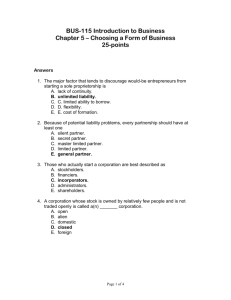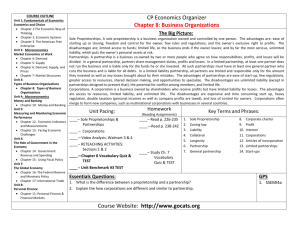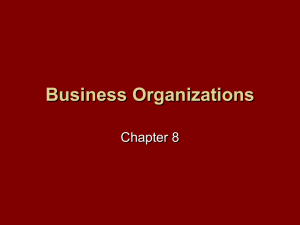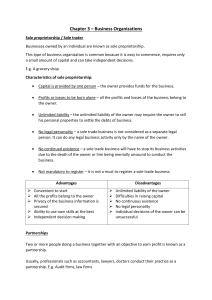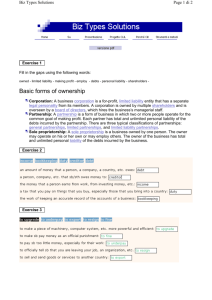Understand the nature of business.
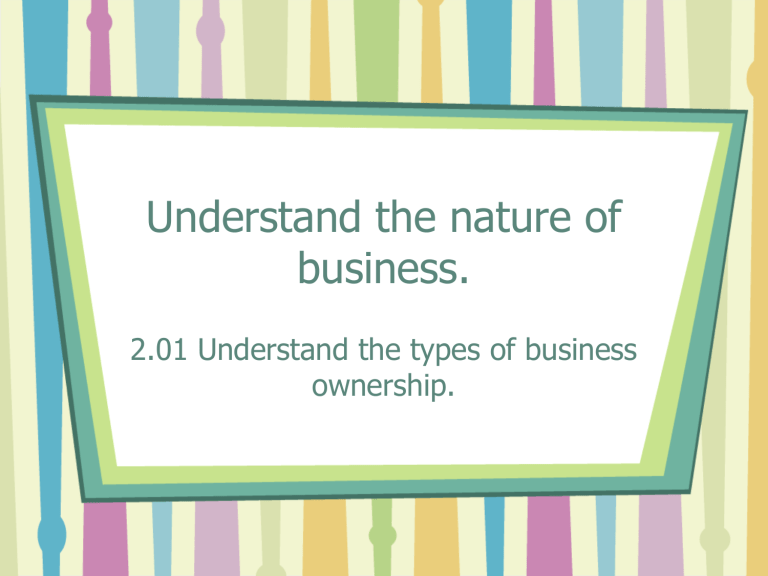
Understand the nature of business.
2.01 Understand the types of business ownership.
Business Ownership
• Sole Proprietorship
• Partnership
• Corporation
• Franchise
Sole proprietorship
• A business owned and run by one person
• The business is typically managed by the owner.
• Formation varies by state.
Advantages
• Easy to start up
• Complete control of the business
• Owner receives all the profits
• Limited taxes (one time taxation)
Disadvantages
• Limited capital (money)
• Unlimited liability (responsible for ALL debt)
• The business is limited to the lifetime of the owner
Partnership
• A business owned and controlled by two or more people who have entered a written agreement
• The management of the company depends on the partnership agreement.
Advantages
• More capital and credit available than a sole proprietorship
• Combined resources (money, expertise)
• Shared management responsibilities
• Shared risk
• Work load easier to manage than a sole proprietorship
Disadvantages
• Profits are shared
• Responsible for each others decisions
• Potential for disagreement among partners
• Unlimited liability (depending on type)
Limited Liability Partnership
• Identifies some investors who cannot lose more than the amount of their investment
• Investors are not allowed to participate in the day-to-day business management
Types of Partnerships
• Dormant partner plays no role and is not known to the public.
• General partner plays an active role and has unlimited liability (every partnership must have at least one general partner).
• Limited participate as investors and have limited liability.
• Secret partner plays an active role but is secret from society.
• Silent partner does not have an active role but is known to the public.
Types of Partnerships
Type of
Partner
Participation in the
Business
Relationship to the
Public
Degree of
Liability
Dormant Not active Unknown Unlimited
General Active Known Unlimited
Limited Not active Known
Secret Active Unknown
Limited
Unlimited
Silent Not active Known Unlimited
11
Corporations
• An organization owned by one or more shareholders and managed by a board of directors.
• Ownership
– Determined by purchase of stock
– A stockholder, or shareholder, owns a ‘piece’ of the company
– One share of common stock equals one vote
Advantages
• Easier to obtain capital
• Limited liability for shareholders
• Life of the corporation is unlimited
Disadvantages
• Double taxation (profits and earnings)
• Government regulations and legal restrictions
• Decision-making shared among managers, board of directors, and shareholders
Specialized Corporations
• Subchapter S (S-corporation)
– treats partners as individuals by taxing them once
• Limited Liability Company
– Provides limited liability protection for owners
• Nonprofit corporation
– A group of people who join to do some activity that benefits the public
Types of Corporations
• Domestic - chartered in a specific state
Examples located in North Carolina:
• Bank of America Corporation
• Lowe’s Home Improvement Store
• Foreign - chartered in one state, but doing business in another state
• Alien - chartered in another nation, but doing business in a state
Types of Corporations continued
• Public-established for a governmental purposes
Examples
• National Science Foundation
• Export-Import Bank of the United States
• Private-established by individuals for business or charitable purposes.
Examples
• Enterprise Rent-A-Car
• American Cancer Society
17
Cooperatives
• Owned by members, serves their needs, and is managed in their interest
• Purchase goods and services cheaper as a group than as individuals
• Greater bargaining power than as individuals
Franchise
• Permission to operate a business to sell products and services in a set way
• Begins with a parent company who owns the product or service and grants the right to another business
• Franchiser: the company that owns the product
• Franchisee: the company purchasing the right to run the business
Types of Franchises
• Business-format
– Requires franchisee to sell products or service in a specific format
• Product trade-name
– Allows franchisee to sell specific products. This format is usually formed by automobile, appliance, and petroleum product


